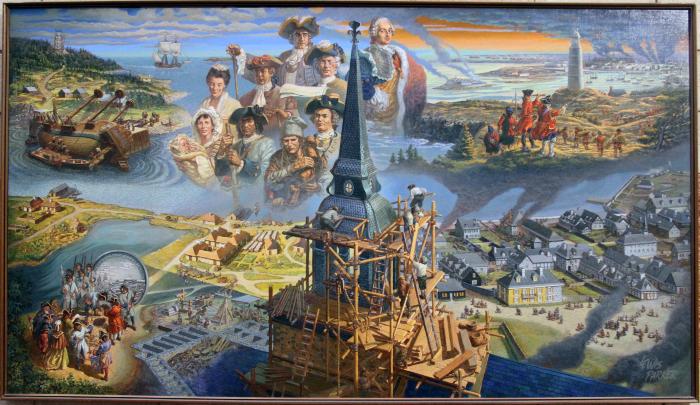Fortress of Louisbourg - 1720 to 1758
X.114.07
The original Louisbourg settlement was founded in 1713 by the French and developed over several decades into a thriving center for fishing and trade. During the 1740s, Louisbourg had a population of around 2500 to 3000, which was fortified against the threat of British invasion. During the turbulent time of empire building, Louisbourg was besieged twice before finally being destroyed in the 1760s. Its siege of 1758 by the British was a turning point in the Anglo-French struggle for what today is Canada. This second siege is depicted in the top right corner of the painting and the British General Wolfe can be seen commanding his troops from Lighthouse Point.
The central scene of the painting depicts the construction of the tower on the King’s Bastion. French stonemasons can be seen installing slate shingles on the roof. The coin featured in the lower left of the painting is a replica of a coin that was discovered inside the cornerstone of the barracks during the reconstruction. The scene on the top left shows a large ship being tipped on its side and being treated with pitch for waterproofing and repairs. The Louisbourg Lighthouse can be seen in the distance.
In the 1960s archaeologists began to reconstruct the fortress and it became the largest historical reconstruction project in North America. It is interesting to note that Parker based many of his historical portraits on people who were working at the Fortress Louisbourg Museum during its reconstruction in the 1970s and 1980s. For example the figure holding plans on the top left of the mural represents Verrier, who was the original engineer and architect at Louisbuourg. Yvon LeBlanc, who was the engineer at Louisbourg from 1972 to 1983, actually posed for this portrait. The figure at top of the painting (holding a stick) depicts the French Governor of Louisbourg, Augustin de Drucour. The exhibition designer of Louisbourg, Horst Paufleur posed for this particular portrait. Other figures below include Ken Donovan, who was a Parks Canada historian and his wife Barbara Donovan (figure holding baby). Lewis Parker adopts this technique throughout many of the paintings and it not only fills in visual gaps within history but also pays homage to contemporary figures within Cape Breton.
